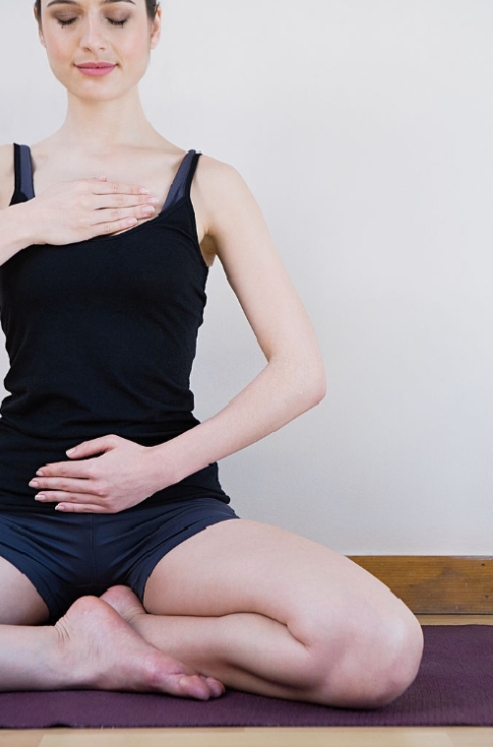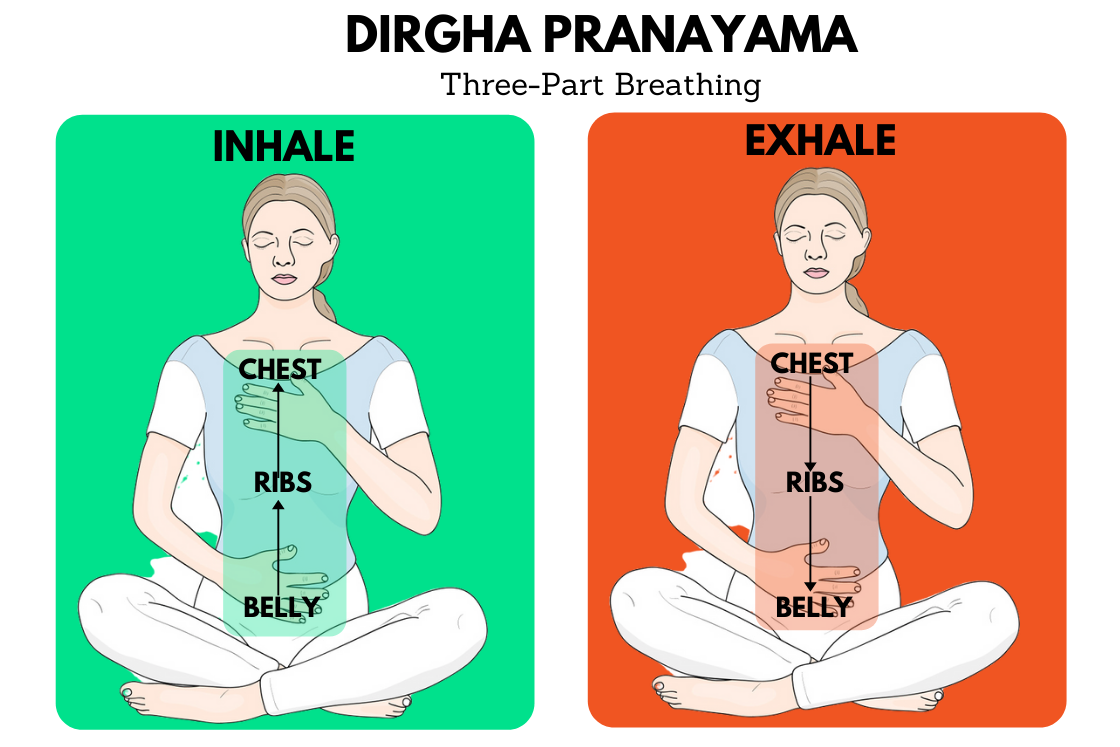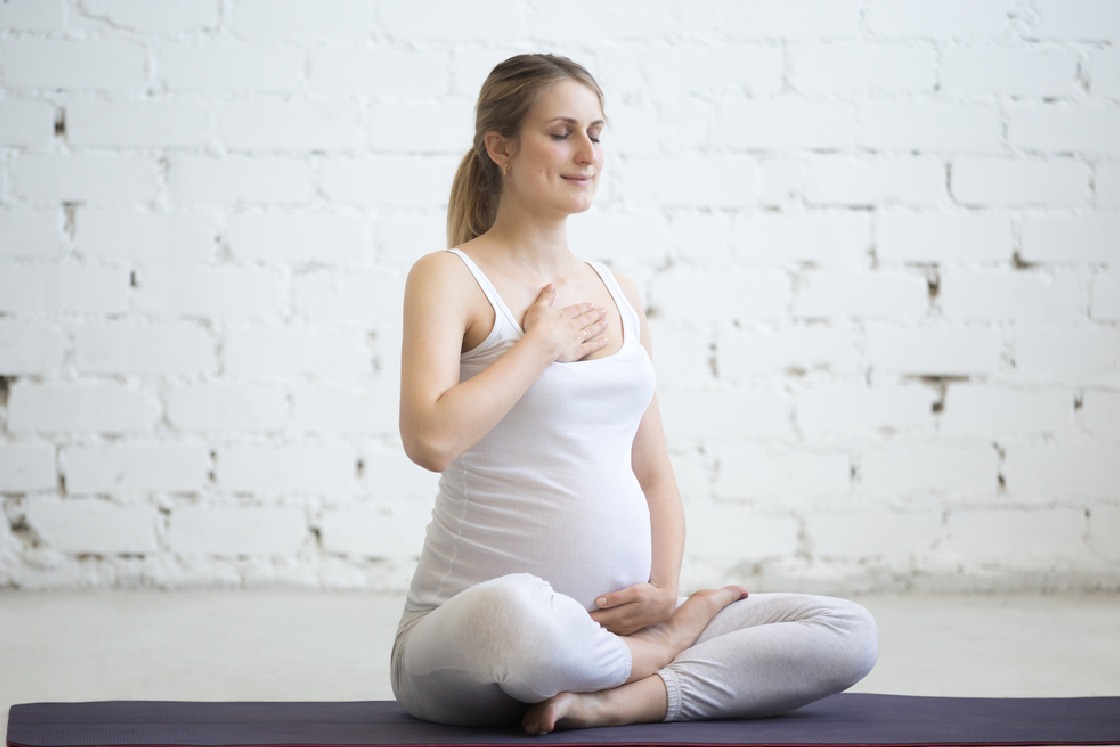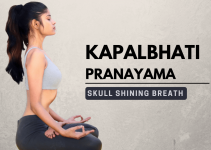
Dirgha Pranayama, also known as Three-Part Breathing, is a technique designed to fully utilise the respiratory organs and maximise lung capacity. Curious about how this works? It’s all about extending the depth of your breath!
Have you ever noticed how deeply you breathe or how far the air moves through your body during inhalation? Take a moment to observe the depth of your breathing.
If your body is stable while breathing, you might find movement primarily in the chest area, with little expansion in the ribcage or abdomen. This type of chest breathing often occurs during a ‘fight or flight’ response and is a sign of shallow breathing, which can contribute to chronic stress.
To address shallow breathing, it is essential to practice involving the entire torso in the deep breathing process. In this article, we will describe Dirgha Pranayama, or three-part breathing, a technique that helps you fully engage your respiratory system.
Dirgha pranayama(deep Breathing) explained
Dirgha is a term from Sanskrit that translates to “deep,” “prolonged,” or “long.” When combined with Pranayama, which means “breath control” or “extension of life force,” it forms a systematic technique for managing our breath, or Prana.
Combining these terms, Dirgha Pranayama involves extending the breath for a longer duration than normal. This means increasing the amount of Prana—or vital life energy—that we bring into our body.
Understand it in this way:
In three-part breathing, we guide Prana to flow through all major parts of the upper body, allowing it to travel deeper within and increasing the duration of breath retention. This extended breathing process is what Sanskrit refers to as Dirgha (deep) Pranayama. In yoga, this technique is unique because it engages all respiratory organs, which is why it is also known as Full Yogic Breathing or Complete Breath.
How three-part breathing works?
Our natural breathing pattern often restricts us to chest-only breathing (thoracic breathing). Because the chest’s movement is limited, the diaphragm—a domed sheet of skeletal muscle separating the chest from the abdomen—does not fully reach the lower parts of the lungs.
As a result, the oxygen we inhale does not fully exchange with the blood, leading to reduced energy production. This shallow breathing can leave us feeling tired after minimal effort and contribute to stress.
In contrast, three-part breathing extends beyond chest breathing and fills all three parts of the torso with oxygen:

- Lower Abdomen: First, fully fill the lower abdomen with air.
- Rib Cage: Next, expand the breath into the chest and side ribs.
- Upper Chest: Finally, extend the breath into the upper chest area by lengthening the collarbone and shoulders.
During exhalation, the process reverses: first, the breath leaves the upper chest, then the rib cage, and finally the abdomen
The diaphragm plays a crucial role in three-part breathing. When we deeply inhale in Dirgha Pranayama, the diaphragm moves to contact the lowest portion of the lungs, where small blood vessels are located. These vessels often do not receive a full share of oxygenated air with shallow breathing. As we inhale deeply, the diaphragm contracts to reach these blood vessels, facilitating a complete exchange of oxygen and aiding in the expulsion of carbon dioxide.
Thus, by increasing the efficiency of oxygen exchange through three-part breathing, we can enhance our overall energy levels and reduce stress.
How to perform dirgha pranayama (steps)
To perform Dirgha Pranayama effectively, find a quiet space where you won’t be disturbed for about 10-15 minutes. You can practice this breathing exercise in the following postures:
- If You’re Comfortable Sitting:
- Choose a seated cross-legged posture, like Easy Pose or Lotus Pose.
- Sit with your sit bones firmly grounded, spine erect, eyes closed, and shoulders relaxed.
- Observe your natural breath for a few cycles to get settled.
- If Sitting is Uncomfortable or You’re a Beginner:
- Lie on your back, either with legs fully extended (as in Savasana) or knees bent with soles on the mat for added comfort.
- In this position, you’ll better feel the movement of your abdomen and rib cage.
In both positions, wear loose clothing to ensure your abdomen can move freely.
Step-by-step instructions
- Observe Your Breath:
- Begin by paying attention to your breath coming in and out of your nostrils. Spend a few breaths just being aware of the subtle sensations.
- First Part: Abdominal Breathing
- Place your left hand on your lower abdomen.
- Inhale deeply, feeling the air fill your abdomen and expand it like a balloon.
- Exhale, allowing your abdominal wall to gently return to its natural position. Press your navel in slightly to expel all the air.
- Repeat this for 5-6 breaths.
- Second Part: Rib Cage Breathing
- Keep your left hand on your abdomen and place your right hand on the right side of your rib cage.
- Inhale, filling your abdomen first, then expand your rib cage with more air. Feel the rib cage movement with your right hand.
- Exhale, letting your ribs compress naturally, then draw your belly in to expel the remaining air.
- Continue for 5-6 breaths.
- Third Part: Full Yogic Breathing
- Keep your left hand on your abdomen and slide your right hand up to your chest.
- Inhale, filling your abdomen, then your rib cage, and finally your chest and collarbone. This completes the breath.
- Exhale in reverse: empty your chest first, then your rib cage, and finally your abdomen.
- Practice this for a few breaths.
- Combine All Three Parts:
- Perform a full round of complete yogic breathing by inhaling deeply, expanding your belly, rib cage, and chest. On the exhale, release breath from the chest, then ribs, and finally your abdomen.
- Continue this combined breathing for 10 rounds, at your own pace.
Tip: Practising Dirgha Pranayama for just 5 minutes can calm your mind and relax your body.
Precautions
- Practice in a quiet, comfortable environment free from disturbances.
- Ensure your clothing is loose to avoid restricting abdominal movement.
- Begin with shorter sessions and gradually increase duration to avoid overexertion.
- If experiencing discomfort, stop immediately and resume normal breathing.
- Maintain proper posture to prevent strain on the back and neck.
- Stay hydrated by drinking water before and after practice.
- Consult a healthcare provider before starting if you have pre-existing health conditions.
Contraindications
- Avoid if you have severe respiratory issues or cardiovascular diseases.
- Not recommended during pregnancy unless supervised by a healthcare professional.
- Discontinue if you feel dizzy, light-headed, or experience significant discomfort.
- Those with severe back or neck pain should consult a specialist before attempting.
Benefits of Dirgha Pranayama

- During pregnancy, women often breathe primarily through their chest because the diaphragm is constrained by the growing fetus. This habit can persist even after childbirth. Dirgha Pranayama helps improve this breathing pattern by encouraging deeper, more complete breaths.
- It helps reduce hypertension (high blood pressure) by relaxing and widening the blood vessels through deep breathing, which in turn lowers elevated blood pressure.
- This breathing technique helps strengthen the digestive system. The intentional movement of the belly in and out during deep breathing massages the abdominal organs, thereby supporting and enhancing digestive function.
- This Pranayama practice also strengthens the immune system. Since 70-80% of the immune system is located in the digestive tract, belly breathing facilitates the movement of lymph (which contains white blood cells) to targeted areas in the body. As a result, the immune system becomes more robust.
- In cases of hypoxia or hypoxemia, where the body is not receiving sufficient oxygen, three-part breathing is beneficial for restoring oxygen levels in the blood.
- Full inhalation provides the body with a sufficient supply of oxygen, while complete exhalation removes stale CO2 accumulated in the lower parts of the lungs, helping to detoxify the body.
- Long deep breathing in this Pranayama saves breath counts for a longer duration. This is the reason ancient yogis used to live a longer life.
- Dirgha Pranayama helps create awareness in the present moment. It calms the mind as all the focus is on the way of breathing that you are currently doing.
- Dirgha pranayama slows down your thoughts and prepares your mind for meditation.
Conclusion
Dirgha Pranayama is a valuable practice for enhancing respiratory health and overall well-being. By mastering this three-part breath, you can experience deeper relaxation, improved mental clarity, and a strengthened immune system. Incorporate Dirgha Pranayama into your daily routine to harness its full potential and enjoy the benefits of a more mindful and healthful life.





Loved the picture, thanks!
“yogic deep breathing” or “three parts breathing” is superb and splendid.
Would like to know about “Chandra bhedi pranayama” for high bp control!
which is correct: both inhale and exhale by left nostril;
or; inhale by left and exhale by right;
repeatedly inhale by left and exhale by right.
Inhale by left and exhale by right is the correct procedure.
Dirgha Pranayama_Bài viết này rất tốt với tôi. Cảm ơn tác giả bài viết này rất nhiều!
Dirgha Pranayama is a wonderful practice. Glad to hear your feedback 🙂
I will try this. Keep posting like this.